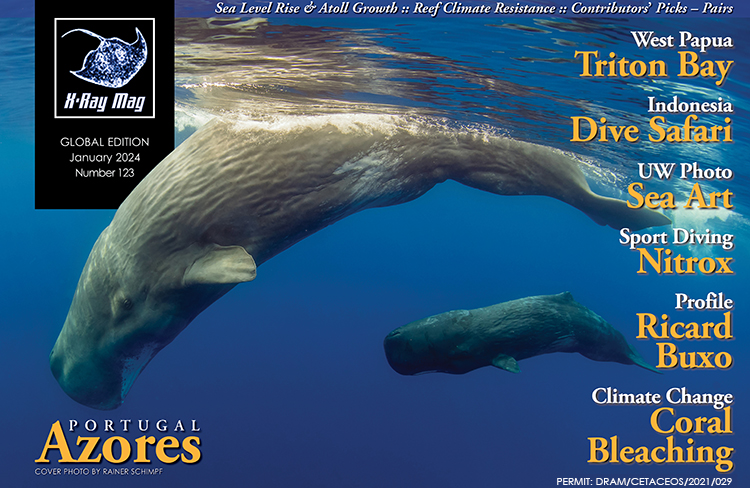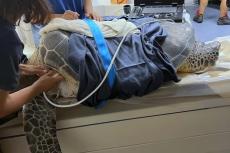How can one capture “abstractionism” in an underwater photo? Underwater photographer Claudio Ziraldo discusses abstract underwater photography and shares some examples of sea art.
Contributed by
“Abstractionism is an artistic experience that arose in the early 20th century … The term indicates those pictorial and plastic works that go beyond the objective representation of reality.” (it.wikipedia.org)
Even in underwater photography, we can search for forms of a kind of “abstractionism.” We can thus make use of the infinite possibilities that the “Blue Continent”1 offers us, capturing images based on the shapes, colours and harmonies that are characteristic of the details found in marine organisms or animals, show associations between life forms, or more simply, can be identified in the incredible and infinite geometries that are a constant in underwater life.
Thus, even the underwater photographer taking unusual and interesting photographs can express graphic or chromatic creativity. And why not even a bit of the “mysterious,” sometimes? Of course, even in this type of photography, rigorous and clean shooting must form the basic foundation for the construction of a good image.
It is obviously necessary to get into a certain kind of mindset—without, of course, forgetting all that one has learnt in previous experiences—and to try our hand at a new kind of visual research, aimed at enhancing our ability to capture details and nuances—to “pick up” mixes and nuances of colours, and to interpret patterns and surface shapes. This “modus fotografandi” is generally referred to as “sea art.”
“Abstractionism arose from the artists’ choice to deny the representation of reality in order to enhance their feelings through shapes, lines and colours … The term ‘abstractionism’ is thus often used to designate all non-figurative forms of visual artistic expression, where there are no footholds that allow the painted image to be traced back to any representation of reality...”
— Stefano Fake, Italian contemporary artist and video designer
Sea urchins

Photo 2 shows a detail of the banded sea urchin (Echinothrix calamaris). It was taken in Indonesian waters with a 60mm macro lens.
In Photo 1 and Photo 3, the same lens was used, plus two strobes to capture the detail of the sea urchin Astropyga radiata, photographed in the waters of Lembeh Strait. Very characteristic of this species are the blue dots (seen in the images), which appear almost luminescent.
And from the magical waters of the Red Sea is an image of the spines of a sea urchin Asthenosoma sp. (Photo 3), a close relative of the fire urchin Asthenosoma varium, which provides shelter for the Coleman shrimp. It was photographed with a 100mm macro lens and a strobe.

This sea urchin is smaller in size than its Asian relative and, to the best of my knowledge, has no symbionts. As can be seen in the image, the spines are formed in a spiral, and at the top are the vesicles with venom and the spikes that inject it. I had a close encounter on the wreck of the Rosalie Moller, a cargo ship of the Barclay Curle & Co shipyard in Glasgow, which sank in 1941 due to bombing. It now lies on the bottom, at a depth of 50m, in the waters of Gubal Seghir island, north of Hurghada.
The sea urchin was resting on the wreck’s broadside, in a shaded area. Given the depth and time of day, there was little light, and I did not see it. I practically just grazed it with the inside of my wrist and almost fainted from the pain.

Corals
In Photo 4, a 60mm lens was used to capture the tentacles of Pseudocorynactis sp., a rather rare corallimorph coral that grows in somewhat dark crevices. The photograph was taken in Lembeh Strait. These corals look a lot like sea anemones but are instead related to madrepores (stony coral).

Photo 5 shows an extensive colony of Palythoa sp. coral polyps covering a vast wall space, captured at full frame, resulting in a fascinating image that has a very pleasing composition and is ultimately also a bit “mysterious.” The photo was taken with a 60mm macro lens and two strobes.
Parrotfish
Parrotfish, given their habit of “sleeping with open eyes” on the reef and their infinite range of colours and patterns, are certainly among the most suitable subjects to begin with, in our experience as “artists of the sea.”

Photo 6 shows a pectoral fin, against a background of the fish’s skin, where one can see the texture of its scales, punctuated by colour, culminating in a highly effective shot, rich in colour and graphic impact.

It is especially necessary to remember that parrotfish, if not completely asleep, will wake up at the flash of strobes, which therefore should be used very sparingly. Powerful strobes are not needed to take close-up shots at night. Use somewhat “dimmed” light settings so as not to disturb the underwater fauna as much as possible.

In Photos 7 and 8, the colours and patterns of a parrotfish’s tail and garish scales, with part of the dorsal fin showing, really leave one speechless. Although I have tried my hand at this type of shooting many times, I never cease to be amazed and fascinated by the magic that these images allow to shine through. If we look at them carefully over time, they will give us a multitude of colourful details which, at first glance, might have escaped us.
True abstract images in underwater photography work when colour is the master and where “the artist” is the sea, while we can only be witnesses to its artistry... I really think it is a great privilege to behold.

To conclude this article (but certainly not this topic), here are two shots of parrotfish eyes, captured with a 60mm macro lens. In the first image (Photo 9), taken in the Maldives, colour has a great impact, with the vibrant colourful patterns of the surrounding fish skin further enhanced by the colourful shapes of the eye and additional vivid elements.

In the second, closer shot, taken in Sudan (Photo 10), we can observe the morphology of the outer visual apparatus of this scarid (parrotfish) and the fascinating mix of soft nuances surrounding it.
Trying your hand at this kind of photography can quickly become a kind of “craze” or obsession, and there is really no limit to experimentation and imagination. ■
1Refers to the 1954 underwater documentary film by Folco Quilici, Sesto Continente (The Blue Continent). (Wikipedia, IMDB)



























